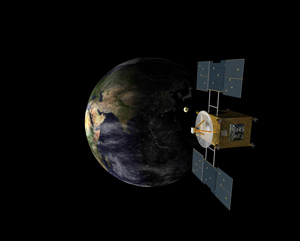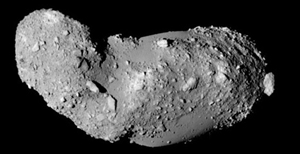 The Japanese mission Hayabusa (“Falcon”) has been nothing if not ambitious. Launched in 2004, it reached the bizarre asteroid Itokawa a little over a year later. It took phenomenal images and other measurements, and even landed on the asteroid itself to take samples, destined to be returned to Earth.
The Japanese mission Hayabusa (“Falcon”) has been nothing if not ambitious. Launched in 2004, it reached the bizarre asteroid Itokawa a little over a year later. It took phenomenal images and other measurements, and even landed on the asteroid itself to take samples, destined to be returned to Earth.
But it has suffered a series of crippling mishaps that have threatened the mission time and again with failure. However, despite all that, the end game is in sight: Hayabusa is almost back home, and on June 13, sometime around 14:00 UT, the sample recovery capsule will parachute down to the Earth.
 This is an unprecedented opportunity for scientists! While meteorites that fall to Earth give us samples of asteroids, this will be the first time we’ll have obtained one that has not been through the perils of atmospheric re-entry directly. Also, Itokawa is just plain weird. As you can see in the picture, it’s covered in rubble, and lacks impact craters! This is strong evidence that it’s not a single, monolithic body; in other words, it’s not a solid rock. It may instead be more like a pile of rubble, an asteroid that has been shattered repeatedly by low-speed impacts with other rocks, but had its own gravity hold it together like a bag full of shattered glass.
This is an unprecedented opportunity for scientists! While meteorites that fall to Earth give us samples of asteroids, this will be the first time we’ll have obtained one that has not been through the perils of atmospheric re-entry directly. Also, Itokawa is just plain weird. As you can see in the picture, it’s covered in rubble, and lacks impact craters! This is strong evidence that it’s not a single, monolithic body; in other words, it’s not a solid rock. It may instead be more like a pile of rubble, an asteroid that has been shattered repeatedly by low-speed impacts with other rocks, but had its own gravity hold it together like a bag full of shattered glass.
Asteroids like this may comprise a significant percentage of all the asteroids we see. And if one of them is headed toward Earth, how we deal with a rubble pile may be very different than how we might try to push a solid rock out of the way. Studying Itokawa is therefore very important… and may just save the world.
The sample return capsule will land in Woomera, Australia, where it hopefully will not be attacked by venomous Koalas (everything Down Under can kill you). I just learned that my old friend and editor J. Kelly Beatty will be there to watch it come back! He’s doing it as part of the high school at which he teaches; go read his remarkable story to learn more.
And expect to hear a lot more about this in the coming weeks, too. It will take a long time to study and understand the actual samples returned, but in the meantime the re-entry itself is very exciting, and hopefully we’ll get cool video of it too.
Tip o’ the Whipple Shield to Mike Murray.
Drawing credit: Corby Waste and Tommy Thompson for NASA / JPL. Image of Itokawa credit: JAXA